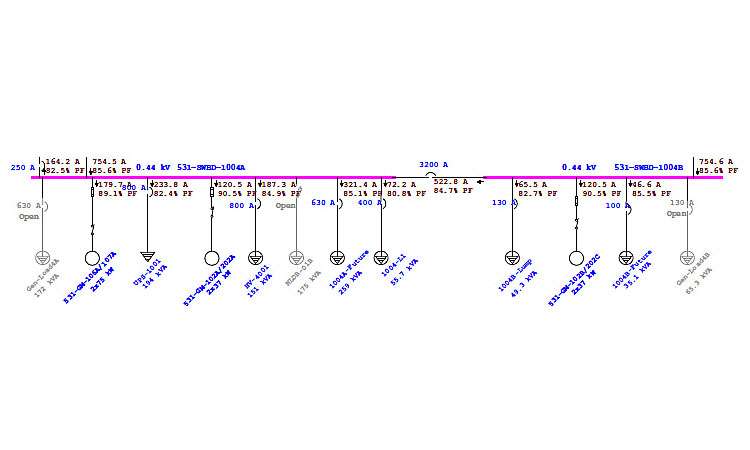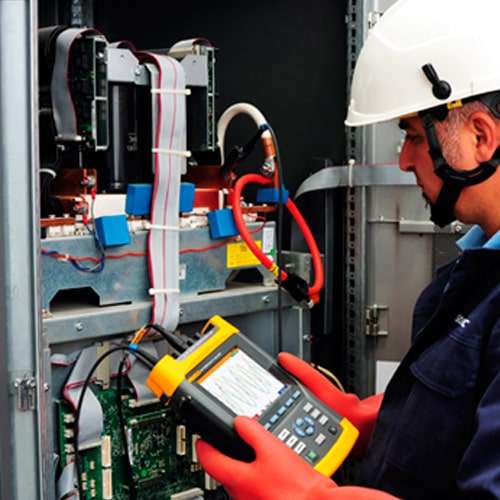Load Flow, Short Circuit, and Relay Coordination in Power System Analysis
In order to provide your facility with a power system that is safe, effective, and reliable for use in both typical and abnormal circumstances, a power system analysis consists of numerous engineering assessments including the application of scientific analytic principles and techniques. The goal of a power system analysis is to comprehend how a system will function in various configurations and the impacts on the system of disturbances such as capacitor switching, the beginning of a large motor, or incident energy from an arc flash. The reliable operation of safety equipment in the case of a short circuit or if any other fault is present may also require a power system analysis.
Studies of power systems are crucial for providing a steady and dependable supply of electricity. Under all operational circumstances, a well-designed power system ensures dependable operation and maximizes plant availability. Outages, flaws, inefficiencies, and impaired safety are all effects of poorly built systems.
Most or all of the following sub-studies may be included in an average power system analysis:
- Analysis and investigation of load flow
- Analysis and investigation of short circuits
- Analysis of relay coordination
- Arc Flash Hazard Analysis & Study
- Analysis of harmonics
- Analysis of dynamics and transients
- Earthing research
We’ll examine the first three studies in this blog. and comprehend the guidelines and methods used to carry out each of these investigations.
Load Flow Analysis and Study:
A load flow study examines an electrical network to ascertain the direction of power flow. It helps in assessing the power system’s operational status as well as the amount of active and reactive power generated, losses, voltage, current, and power factor.
The analysis of load flow involved the following three phases:
- Network and component modeling for power systems
- The creation of equations for load flow.
- Using numerical techniques to solve the equations relating load and flow.
Three methods are used to calculate the power system data:
- The Gauss-Seidel System is one of the most used analytical techniques. This approach has the advantages of being simple to use, requiring little computational power, and finishing quicker. However, more iterations are required due to the slow convergence. As the number of buses rises, so does the number of iterations.
- The Newton-Raphson method is more sophisticated and uses quadratic convergence, which is helpful in complex situations. This method uses less processing power since it requires fewer iterations to reach convergence. It is even more exact since it is less susceptible to complicated factors like regulating transformers or slack bus selection. One drawback is that programming can be challenging and requires a lot of machine memory.
- Another method for performing load flow analysis is the Fast Decoupled Load Flow System (FDLF). This method’s main advantage is that it uses less computer memory. It is a popular substitute for real-time power grid management since the calculation speed is 5 times faster than the Newton-Raphson method. This piece of software can only be used in certain situations. It is therefore more challenging to adapt it to consider other issues like flow or system protection in the power industry.
Short Circuit Analysis & Study:
One or more of the following types of short circuits will be included in a short circuit analysis:
- Line-to-line fault, which occurs when two phases are simultaneously shorted out.
- One phase only contacts the ground in a single line-to-ground fault.
- Double line-to-ground fault, in which the ground and both phases are simultaneously shorted.
- The three phases are all shorted together in a three-phase fault.
Once the type of defect is identified, creating a one-line schematic of the power distribution system will be simpler. Calculate short circuits using the generated single-line diagram and an impedance diagram with numerical values for the utility source, transformer, and conductor in relation to the usable voltage of each component. Calculated values include short circuit current, transformer multiplier, and full-load amps. In order to verify that the power distribution system is outfitted with the proper safety devices at various locations to prevent danger and downtime, it is crucial to compare the acquired results with the equipment ratings.
Analysis of Relay Coordination:
Since coordination systems guarantee quick, dependable, and selective relay operations to isolate the fault, relay coordination is an essential component of power system protection architecture. The degree to which overcurrent protective devices are necessary for the power system is determined by the coordination analysis. It also helps in figuring out the requirements, arrangements, and dimensions necessary to strike a compromise between equipment security and restricted system function.
With the use of power system software like ETAP, data collection operations are carried out to simulate the system. Short circuit analysis is done initially, then the fault currents at each electrical point in the system are measured. The effects of system equipment failures are then minimized by selecting and calibrating the protective devices. To identify areas of coordination failure, the time-current characteristic curves of the protective device are measured and compared. To achieve selective and dependable operation of protective devices, adjustments are performed as necessary.
Power system analysis benefits include:
- Reliability of the power system is increased.
- Using equipment with the proper rated power system.
- Increased safety and decreased danger from electrical hazards.
- Adherence to applicable regulatory requirements and electrical installation codes.
- The suggestion of alternative techniques to enhance the system’s performance and dependability.
- For any upcoming inspections, a record of the current state of the power system is made.
In order to monitor the voltage at different buses as well as the actual and reactive power flow between buses, analyze the system under various fault conditions, and determine the system’s resilience to minor and significant disturbances, Care Labs offers Load Flow study & analysis, Short Circuit study & analysis, and Relay coordination analysis.
Contact us or request a quote to get a power system analysis for your business in Greece. Within 24 hours, one of our support staff members will respond.
Share Post
Related Posts
-
How to Conduct Power Quality Analysis in Greece
-
Power Quality Working Principles in Greece
-
The Importance of Load Flow and Short Circuit Analysis for a Greek Business
-
Test and Verify Electrical Motor Efficiency in accordance with Greek Guidelines
-
How to evaluate efficiency and dependability of commercial motors?
-
Arc Flash Analysis in Greece: A Step-by-Step Guide
-
Load Flow, Short Circuit, and Relay Coordination in Power System Analysis
-
Why is Harmonic Analysis and Study Important for Greek Businesses?
-
Importance of Arc Flash Hazard Analysis and Mitigation Methods
-
Harmonic Analysis in Power System in Greece






